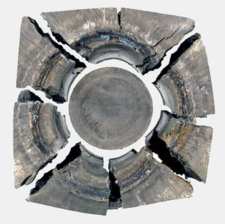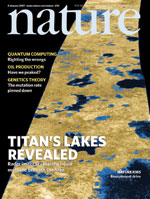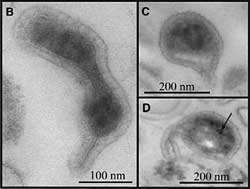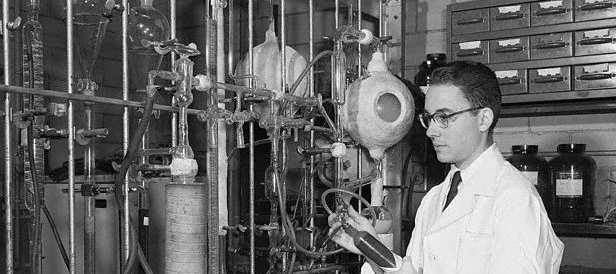What'sNEW Archives, January–April 2007
 4 April 2007 4 April 2007
 How did life on Earth originate? The words on Earth make it an unusually well-posed question. It is the headline of an article on Physorg.com about research at the Fraunhofer Institute for High-Speed Dynamics at Germany's Ernst-Mach-Institut (EMI). To simulate the shock wave that occurs when a meteorite crashes into a planet, an EMI team used cylindrical explosives to briefly crush a thin layer of microbes between two flat-milled stone plates (post-explosion photo at right). Although the microbes experienced pressure 400,000 times that of air at sea level, a small minority survived. The main reason [is] that the inhospitably high pressure only lasts for a fraction of a second just like the impact of a meteorite, explained team leader Ulrich Hornemann.
How did life on Earth originate? The words on Earth make it an unusually well-posed question. It is the headline of an article on Physorg.com about research at the Fraunhofer Institute for High-Speed Dynamics at Germany's Ernst-Mach-Institut (EMI). To simulate the shock wave that occurs when a meteorite crashes into a planet, an EMI team used cylindrical explosives to briefly crush a thin layer of microbes between two flat-milled stone plates (post-explosion photo at right). Although the microbes experienced pressure 400,000 times that of air at sea level, a small minority survived. The main reason [is] that the inhospitably high pressure only lasts for a fraction of a second just like the impact of a meteorite, explained team leader Ulrich Hornemann.Because meteorites are not flat, the EMI team also asked if impact pressure might be reduced in small crevices. It is. EMI's project partners at the German Aerospace Center added, ...The small fissures are also advantageous to the tiny organisms in other ways, providing them with protection on their journey through space against UV radiation, solar wind and the icy cold.... Hornemann concludes that life on Earth may have come here from other planets.
 How did life on Earth originate?, Physorg.com, 3 Apr 2007. How did life on Earth originate?, Physorg.com, 3 Apr 2007.
 The Fraunhofer Institute for High-Speed Dynamics, Ernst-Mach-Institut (EMI), Germany. The Fraunhofer Institute for High-Speed Dynamics, Ernst-Mach-Institut (EMI), Germany.
 Bacteria... is a related CA webpage. Bacteria... is a related CA webpage.
 Comets... is a related CA webpage. Comets... is a related CA webpage.
 Thanks, Stan Frankin and Yahoo!Alerts. Thanks, Stan Frankin and Yahoo!Alerts.
But another perspective predominates the subject. There are two mutually exclusive theories on the origin of life. The 'pioneer organism theory' claims a momentary, mechanistically definite origin by autocatalytic carbon fixation within a hot, volcanic flow in contact with transition metal catalysts.... The 'prebiotic soup theory' claims a protracted, mechanistically obscure self-organization in a cold, primitive ocean, in which organic compounds accumulated over thousands or millions of years'. This is how German chemists Claudia Huber and Günter Wächtershäuser open their defense of their now-fashionable theory involving metal catalysts. The attack came in Science from distinguished North American proponents of the older, more mainstream prebiotic soup theory. The soup-theory group agrees, "There are two main theories for the origin of life on Earth." One of the attacking soup-theorists was Stanley Miller (pictured below, c. 1953), a pioneer of that theory. Miller's protege, Jeffrey Bada, claims recent advances in soup theory at the American Chemical Society annual meeting in Chicago this week. Yet even this theory has no consensus, as RPI chemist James Ferris and Princeton astrobiologist Christopher Chyba attest in commentary in Scientific American.
After so much effort without resolution, shouldn't we consider other possibilities for the origin of life on Earth? But first, we must ask the right question.
 Jeffrey L. Bada, Bruce Fegley Jr., Stanley L. Miller, Antonio Lazcano, H. James Cleaves, Robert M. Hazen and John Chalmers, "Debating Evidence for the Origin of Life on Earth" [text], 10.1126/science.315.5814.937c, p 937-938; and Jeffrey L. Bada, Bruce Fegley Jr., Stanley L. Miller, Antonio Lazcano, H. James Cleaves, Robert M. Hazen and John Chalmers, "Debating Evidence for the Origin of Life on Earth" [text], 10.1126/science.315.5814.937c, p 937-938; and
 Claudia Huber and Günter Wächtershäuser, "Response," p 938-939 v 315, Science, 16 Feb 2007. Claudia Huber and Günter Wächtershäuser, "Response," p 938-939 v 315, Science, 16 Feb 2007.
 Primordial Soup's On: Scientists Repeat Evolution's Most Famous Experiment, by Douglas Fox, ScientificAmerican.com, 28 Mar 2007. Primordial Soup's On: Scientists Repeat Evolution's Most Famous Experiment, by Douglas Fox, ScientificAmerican.com, 28 Mar 2007.
 The RNA World is the main CA webpage about origin-of-life theories. The RNA World is the main CA webpage about origin-of-life theories.
 What Difference Does It Make? is a CA webpage discussing right and wrong questions. What Difference Does It Make? is a CA webpage discussing right and wrong questions.
 29 March 2007 29 March 2007
I felt sick to my stomach.... They were talking about genes involved in brain development having come directly from bacteria — Jonathan Eisen, the University of California, Davis
When the sequence of the Human genome was first published in 2001, one surprise was evidence that 100-200 human genes had come directly from bacteria. Darwinists reacted strongly. "How could this possibly happen?" wondered James Brown, leader of GlaxoSmithKline's study of the phenomenon. Michael Stanhope, a member of his team, commented, "The original claim does nothing but fuel paranoid thoughts about gene transfer."
"Sure enough... flabbergasted evolutionary biologists rapidly shot the claim down," John Whitfield now reports in Nature. "The genes in question were more likely to have been present in the common ancestor of humans and bacteria but then lost in other lineages." And two geneticists at Emory University have commented, "Because selection is weak relative to drift in small populations, fixation of a laterally transferred gene in a characteristically small vertebrate population would require an exceptionally large fitness benefit."
| The evolution of the animals has plagued us for years. We're hitting a wall. — Antonis Rokas, Massachusetts Institute of Technology |
This latter objection actually contains a crucial insight. Newly delivered genetic programs, if they are appropriate and timely, could provide a dramatic benefit. For example, new research asks if the acquisition of an advantageous gene improved human brains. But okay, suppose some or all of the 100-200 human genes were not transferred directly from bacteria. Perhaps various other transfer pathways were employed. Perhaps some of the subject genes were actually inherited vertically. In any of the scenarios preferred by darwinists, how would brain development genes evolve long before there was any need for them?
 John Whitfield, "Linnaeus at 300: We are family" [text], 10.1038/446247a, p 247-249 v 446, Nature, 15 Mar 2007. John Whitfield, "Linnaeus at 300: We are family" [text], 10.1038/446247a, p 247-249 v 446, Nature, 15 Mar 2007.
 Diane P. Genereux and John M. Logsdon Jr, "Much ado about bacteria-to-vertebrate lateral gene transfer" [abstract], 10.1016/S0168-9525(03)00055-6, p 191-195 v 19, Trends in Genetics, Apr 2003. Diane P. Genereux and John M. Logsdon Jr, "Much ado about bacteria-to-vertebrate lateral gene transfer" [abstract], 10.1016/S0168-9525(03)00055-6, p 191-195 v 19, Trends in Genetics, Apr 2003.
 Victor DeFilippis and Luis P. Villarreal, "Lateral gene transfer or viral colonization?" [text], 10.1126/science.293.5532.1048a, p 1048 v 293, Science, 10 Aug 2001. "Every pattern consistent with [bacteria-to-vertebrate transfer] could alternately be explained by transfer from a viral colonist...." Victor DeFilippis and Luis P. Villarreal, "Lateral gene transfer or viral colonization?" [text], 10.1126/science.293.5532.1048a, p 1048 v 293, Science, 10 Aug 2001. "Every pattern consistent with [bacteria-to-vertebrate transfer] could alternately be explained by transfer from a viral colonist...."
 Setting the Record Straight, by Edward R. Winstead, Genome News Network, 25 Jun 2001. Setting the Record Straight, by Edward R. Winstead, Genome News Network, 25 Jun 2001.
 12 Feb 2001: Our What'sNEW article about the human genome sequencing project. 12 Feb 2001: Our What'sNEW article about the human genome sequencing project.
 Viruses and Other Gene Transfer Mechanisms is the main related CA webpage [ Viruses and Other Gene Transfer Mechanisms is the main related CA webpage [ What'sNEW about HGT What'sNEW about HGT  ]. ].
 Metazoan Genes Older Than Metazoa? is a related CA webpage. Metazoan Genes Older Than Metazoa? is a related CA webpage.
 Human Genome Search... is a related CA webpage. Human Genome Search... is a related CA webpage.
 28 Nov 2006: Did the acquisition of an advantageous gene improve human brains? 28 Nov 2006: Did the acquisition of an advantageous gene improve human brains?
 20 March 2007 20 March 2007
...The movement of plant genes across the landscape involves a complex web of pollinators and fruit-eating animals.
 Katriona Shea, "How the Wood Moves" [summary], 10.1126/science.1136096, p 1231-1232 v 315, Science, 2 Mar 2007. Katriona Shea, "How the Wood Moves" [summary], 10.1126/science.1136096, p 1231-1232 v 315, Science, 2 Mar 2007.
 Viruses and Other Gene Transfer Mechanisms is the main related CA webpage [ Viruses and Other Gene Transfer Mechanisms is the main related CA webpage [ What'sNEW about HGT What'sNEW about HGT  ]. ].
 20 March 2007 20 March 2007
All retroviruses are very old, despite what many card-carrying evolutionary biologists have been saying — John Coffin, a leading retrovirologist at Tufts University in Boston, Massachusetts
 Rabbits Shed Light on Virus's Origins, by Jon Cohen, ScienceNOW, 19 Mar 2007. Rabbits Shed Light on Virus's Origins, by Jon Cohen, ScienceNOW, 19 Mar 2007.
 Viruses and Other Gene Transfer Mechanisms is the main related CA webpage [ Viruses and Other Gene Transfer Mechanisms is the main related CA webpage [ What'sNEW about HGT What'sNEW about HGT  ]. ].
 Metazoan Genes Older Than Metazoa? is a related CA webpage. Metazoan Genes Older Than Metazoa? is a related CA webpage.
 12 March 2007 12 March 2007
More about gene transfer — A team from California and Tennessee observe in Nature that bacteria often swap much larger blocks of DNA than previously thought. And in PNAS two biologists at Berkeley conservatively survey the unobscured evidence for horizontal gene transfer in all domains.
 Ian Lo et al., "Strain-resolved community proteomics reveals recombining genomes of acidophilic bacteria" [html], 10.1038/nature05624, p 537-541 v 446, Nature, 29 Mar (online 7 Mar) 2007. Ian Lo et al., "Strain-resolved community proteomics reveals recombining genomes of acidophilic bacteria" [html], 10.1038/nature05624, p 537-541 v 446, Nature, 29 Mar (online 7 Mar) 2007.
 In-Geol Choi and Sung-Hou Kim, "Global extent of horizontal gene transfer" [abstract | full text], 10.1073/pnas.0611557104, p 4489-4494 v 104, Proc. Natl. Acad. Sci. USA, 13 Mar (online 7 Mar) 2007. In-Geol Choi and Sung-Hou Kim, "Global extent of horizontal gene transfer" [abstract | full text], 10.1073/pnas.0611557104, p 4489-4494 v 104, Proc. Natl. Acad. Sci. USA, 13 Mar (online 7 Mar) 2007.
 Sharing genes a common affair, studies show by Robert Sanders, UC Berkeley (+Physorg.com +EurekAlert), 8 Mar 2007. Sharing genes a common affair, studies show by Robert Sanders, UC Berkeley (+Physorg.com +EurekAlert), 8 Mar 2007.
 Viruses and Other Gene Transfer Mechanisms is the main related CA webpage [ Viruses and Other Gene Transfer Mechanisms is the main related CA webpage [ What'sNEW about HGT What'sNEW about HGT  ]. ].
 Thanks, Stan Frankin. Thanks, Stan Frankin.
 12 February 2007 12 February 2007
The emerging picture of microbes as gene-swapping collectives demands a revision of such concepts as organism, species and evolution itself — Nigel Goldenfeld and Carl Woese
 Nigel Goldenfeld and Carl Woese, "Biology's next revolution" [text], 10.1038/445369a, p 369 v 445, Nature, 25 Jan 2007. Nigel Goldenfeld and Carl Woese, "Biology's next revolution" [text], 10.1038/445369a, p 369 v 445, Nature, 25 Jan 2007.
 Horizontal Gene Transfer Adds To Complexity, Speed Of Evolution, Rice University, 29 Jan 2007. Horizontal Gene Transfer Adds To Complexity, Speed Of Evolution, Rice University, 29 Jan 2007.
 Viruses and Other Gene Transfer Mechanisms is the main related CA webpage [ Viruses and Other Gene Transfer Mechanisms is the main related CA webpage [ What'sNEW about HGT What'sNEW about HGT  ]. ].
 Thanks, Tom Ray and Stan Frankin. Thanks, Tom Ray and Stan Frankin.

 2 February 2007 2 February 2007
Radar reveals methane lakes on Titan. NASA's Cassini spacecraft captured images of more than 75 irregular dark patches in depressions in Titan's high northern latitudes during a flyby, 22 July 2006. Methane lakes are consistent with the hydrological cycle expected to prevail on this cold moon of Saturn. The source of Titan's methane is has not been determined. We wonder if our own planet, when it was much colder, ever had methane lakes. Did they become the natural gas deposits we mine today? Besides the lakes, Titan's dense, nitrogen-dominated atmosphere is another anomaly. Earth has the only similar atmosphere in the solar system. Could Gaian biological processes have produced these similar phenomena on both bodies?
 E. R. Stofan et al., "The lakes of Titan" [abstract], 10.1038/nature05438, p 61-64 v 445, Nature, 4 January 2007. E. R. Stofan et al., "The lakes of Titan" [abstract], 10.1038/nature05438, p 61-64 v 445, Nature, 4 January 2007.
 Titan's Dark Mirror, by Phil Berardelli, ScienceNOW, 18 Feb 2007. Titan's Dark Mirror, by Phil Berardelli, ScienceNOW, 18 Feb 2007.
 Gaia is a related CA webpage. Gaia is a related CA webpage.
 ...Life on Europa or Other Moons? has links to related news articles. Search for "Titan". ...Life on Europa or Other Moons? has links to related news articles. Search for "Titan".

 22 January 2007 22 January 2007
...The bacteria and newfound Archaea ...are archetypes of the kind of life that could exist on other planets, such as in the iron- and sulfur-rich soil of Mars. — biologist Jill Banfield of the University of California, Berkeley
 Brett J. Baker et al., "Lineages of Acidophilic Archaea Revealed by Community Genomic Analysis" [abstract], 10.1126/science.1132690, p 1933-1935 v 314, Science, 22 Dec 2006. Brett J. Baker et al., "Lineages of Acidophilic Archaea Revealed by Community Genomic Analysis" [abstract], 10.1126/science.1132690, p 1933-1935 v 314, Science, 22 Dec 2006.
 Shotgun sequencing finds nanoorganisms, by Robert Sanders, UC Berkeley News, 21 Dec 2006. Shotgun sequencing finds nanoorganisms, by Robert Sanders, UC Berkeley News, 21 Dec 2006.
 Bacteria... is a related CA webpage. Bacteria... is a related CA webpage.
 Life on Mars! includes a discussion of nanobes. Life on Mars! includes a discussion of nanobes.
 Thanks, Jerry Chancellor. Thanks, Jerry Chancellor.
 10 January 2007 10 January 2007
...It is not enough that companies make disclosures of financial information.... In addition it is vital that there be a set of financial intermediaries, who are at least as competent at receiving, processing and interpreting financial information ... as the companies are at delivering it — Yale Law professor Jonothan Macey, writing about the financial collapse of Enron.
Macey was cited in a New Yorker article suggesting that, prior to its collapse in 2001, Enron's extreme financial fragility was not concealed from the public — it was disclosed in the company's own financial statements. The condition went unnoticed because the financial statements were convoluted and took great effort to understand. Almost everyone relied on Enron itself to explain the situation. Of course, Enron explained that everything was fine. An analogous situation governs our understanding of evolution. The same researchers who deliver the scientific data are the ones who interpret it for us. Virtually all of these researchers are committed darwinists (although they may disagree about some of the details.) Naturally, they give the data thoroughly darwinian interpretations. But here as well, we may need competent intermediaries to provide unbiased explanations. As scientific specialties proliferate and narrow, the need only grows.
 Malcolm Gladwell, "Open Secrets," p 44-53, The New Yorker, 8 Jan 2007. Malcolm Gladwell, "Open Secrets," p 44-53, The New Yorker, 8 Jan 2007.
 Bats and horses are closely related is an example of a thoroughly darwinian, and hardly credible, interpretation of a surpising data set, 20 Jun 2006. Bats and horses are closely related is an example of a thoroughly darwinian, and hardly credible, interpretation of a surpising data set, 20 Jun 2006.
 The key to early eye evolution? gives another example in which the darwinian account of the data strains credulity, 21 May, 2005. The key to early eye evolution? gives another example in which the darwinian account of the data strains credulity, 21 May, 2005.
 8 January 2007 8 January 2007
| CO2+3H2O↔CH2O+2H2O2 | (1) | |
CH2O+H2O2↔HCOOH+2H2O | (2) | |
2H2O2→2H2O+O2 | (3) |
The findings by the Viking experiments are reinterpreted. ...The hitherto mysterious oxidant in the Martian soil, which evolves oxygen when humidified, might be H2O2 of biological origin.
 Joop M. Houtkooper and Dirk Schulze-Makuch, "A Possible Biogenic Origin for Hydrogen Peroxide on Mars: The Viking Results Reinterpreted" [8-page PDF], Arxiv.org, n.d. Joop M. Houtkooper and Dirk Schulze-Makuch, "A Possible Biogenic Origin for Hydrogen Peroxide on Mars: The Viking Results Reinterpreted" [8-page PDF], Arxiv.org, n.d.
 Dirk Schulze-Makuch and J. M. Houtkooper, "Life on Mars? Reinterpretation of the Viking Life Detection Experiments: A Possible Biogenic Origin of Hydrogen Peroxide," abstract 035.03 [all abstracts in PDF, 595 pages], AAS/AAPT Joint Meeting, Seattle Washington, 5-10 Jan 2007. Dirk Schulze-Makuch and J. M. Houtkooper, "Life on Mars? Reinterpretation of the Viking Life Detection Experiments: A Possible Biogenic Origin of Hydrogen Peroxide," abstract 035.03 [all abstracts in PDF, 595 pages], AAS/AAPT Joint Meeting, Seattle Washington, 5-10 Jan 2007.
 New Analysis of Viking Mission Results Indicates Presence of Life on Mars, Newswise.com, 7 Jan 2007. New Analysis of Viking Mission Results Indicates Presence of Life on Mars, Newswise.com, 7 Jan 2007.
 Life on Mars! and Life on Mars! and
 Bacteria... are related CA webpages. Bacteria... are related CA webpages.
 John Bilon wants more, 28 Jan 2007. John Bilon wants more, 28 Jan 2007.
|
 How did life on Earth originate? The words on Earth make it an unusually well-posed question. It is the headline of an article on Physorg.com about research at the Fraunhofer Institute for High-Speed Dynamics at Germany's Ernst-Mach-Institut (EMI). To simulate the shock wave that occurs when a meteorite crashes into a planet, an EMI team used cylindrical explosives to briefly crush a thin layer of microbes between two flat-milled stone plates (post-explosion photo at right). Although the microbes experienced pressure 400,000 times that of air at sea level, a small minority survived. The main reason [is] that the inhospitably high pressure only lasts for a fraction of a second just like the impact of a meteorite, explained team leader Ulrich Hornemann.
How did life on Earth originate? The words on Earth make it an unusually well-posed question. It is the headline of an article on Physorg.com about research at the Fraunhofer Institute for High-Speed Dynamics at Germany's Ernst-Mach-Institut (EMI). To simulate the shock wave that occurs when a meteorite crashes into a planet, an EMI team used cylindrical explosives to briefly crush a thin layer of microbes between two flat-milled stone plates (post-explosion photo at right). Although the microbes experienced pressure 400,000 times that of air at sea level, a small minority survived. The main reason [is] that the inhospitably high pressure only lasts for a fraction of a second just like the impact of a meteorite, explained team leader Ulrich Hornemann.

